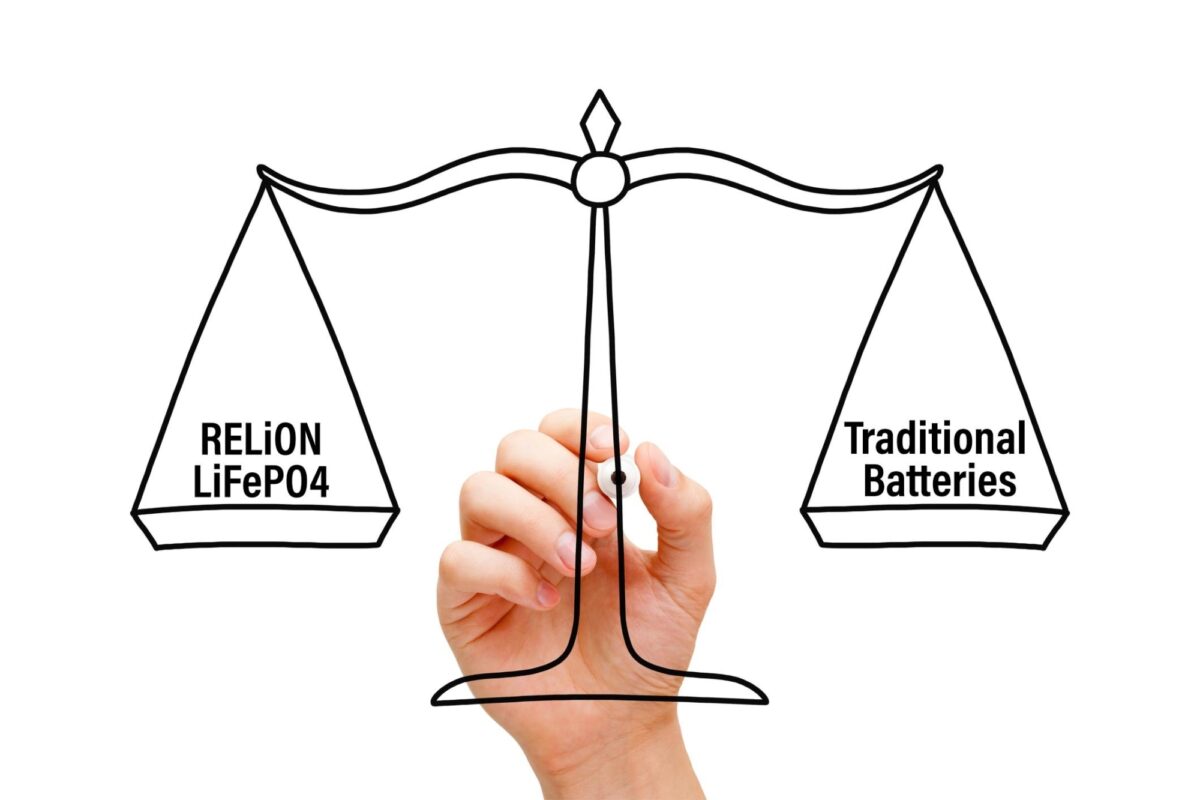Compared to lead-acid batteries, RELiON’s lithium iron phosphate (LiFePO4) batteries offer users practical advantages such as lighter weight and hands-off operation. These batteries also have longer lifetimes which makes for far less frequent battery replacements and service calls. But many first-time buyers of LiFePO4 batteries wonder if their higher purchase price compared to lead-acid batteries makes sense in terms of total cost of ownership. Do LiFePO4 batteries cost more, or less, than lead-acid batteries over their operation lifetime? In this article, we present the results of a simple calculation that compares the total cost of ownership of a LiFePO4 battery compared to three competing lead-acid technologies.
Elements of Total Cost of Ownership
To estimate the total cost of ownership of several battery technologies, we performed a simple cost calculation of RELiON’s RB100 lithium iron phosphate battery and three equivalent size (BCI Group 31) off-the-shelf lead-acid battery technologies: flooded lead-acid (FLA), Absorbent Glass Mat (AGM), and Gel. We took into account the most important factors such as:
- Initial cost of the battery. The up-front retail cost of the battery, the largest cost of initial installation.
- Labor cost of installation. A nominal cost of installing a battery, often performed by a skilled technician who in some cases must be scheduled and dispatched to the customer’s site. This cost is approximately the same for each battery type, however, the process must be repeated multiple times with lead-acid batteries over the life of a single LiFePO4 battery.
- Labor cost of maintenance. In the case of flooded lead-acid batteries, for example, this includes checking and topping off water levels and cleaning acid residue off the battery, and often the surrounding area, as well as cleaning and/or replacing nuts and bolts and cables that have become badly corroded. Lithium-ion batteries require no maintenance during their lifetime.
- Battery replacement costs. Includes a new replacement battery plus the cost of removal and installation by a qualified technician.
- Cost of charging. The nominal cost of electricity for charging the battery. It includes the need for overcharging lead-acid batteries to avoid stratification (the accumulation of lead sulfate on the battery’s plates). In our calculations, we assumed a DOD (depth-of-discharge) of 80% on all batteries before recharging was necessary.
Along with the initial cost of the battery, perhaps the most critical factor in estimating the total cost of ownership is the specified lifetime of the battery in terms of the number of cycles until end of life. For our calculations, we took end of life to be when each battery fails to deliver 50% of its initial capacity for lead-acid batteries and 70% for LiFePO4 batteries. The table below shows the retail price and expected number of cycles until end of life, taken from retail websites and the manufacturer’s published data sheets, of the four batteries used in this analysis.

Total Cost Of Ownership: LiFePO4 vs Lead-Acid
The total cost of ownership of each battery was calculated over a single lifecycle of the RELiON RB100 since it has the longest life of all four batteries. Each of the three lead-acid batteries requires multiple replacements over the life of the RELiON 100Ah LiFePO4 battery. For this calculation, we factored in purchase costs, electricity costs, battery maintenance costs, installation, replacement costs, and the cycle life associated with the 3 lead-acid battery types.

The table above shows each factor in the overall total cost of ownership for each battery. Based on the specified lifetime of each battery, their retail prices, and maintenance expenses that come with lead-acid, it’s clear the total cost of the RELiON RB100 battery is far less in terms of each cycle and in terms of the overall cost of ownership.
While the lead acid batteries have a far lower up-front cost, they require frequent replacement. The FLA batteries could require up to 14 replacements, AGM up to 20 replacements, and the more cost-effective Gel batteries up to 7 replacements over the life of a single RB100. The total cost of ownership of the RB100 was over half that of the Gel battery, the most economical of the three lead-acid batteries.
RELiON’s long-lived LiFePO4 batteries reduce the inconvenience and expense of replacement and service calls, and they lend peace of mind to many users when it comes to demanding applications. As this article shows, LiFePO4 batteries are also beneficial to the bottom line. Our calculation compares the total cost of ownership of RELiON’s RB100, a 12V 100 Ah LiFePO4 battery, to three equivalent size (BCI Group 31) off-the-shelf lead-acid battery technologies. Using measured lifetimes taken from the manufacturer’s published specifications of each battery, our analysis shows that the RB100 is much more cost effective the even the most efficient lead-acid batteries.
To learn more about how to calculate your energy needs and find the optimal battery for your application and usage, visit our Lithium Battery Selector Tool.
If you are interested in learning more about the RELiON LiFePO4 Batteries, please contact one of our experts to answer any of your questions.
